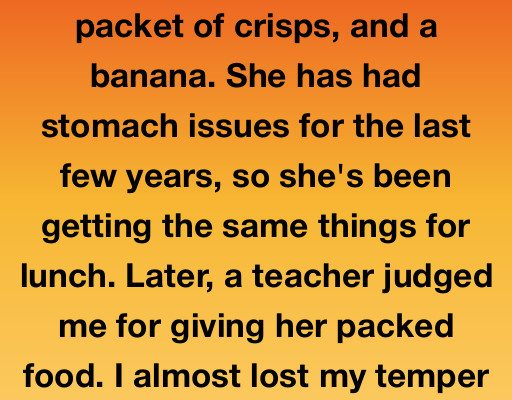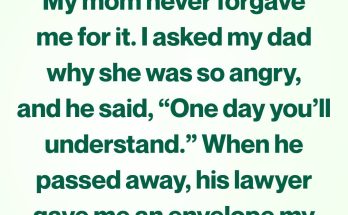I almost lost my temper when she threatened my daughter, saying she’d be forced to eat the school meals starting the next week—no exceptions. At first, I thought I must’ve misunderstood. I asked, calmly, “Sorry, what do you mean by ‘forced’?”
The teacher, a stern-looking woman named Mrs.
Dore, crossed her arms. “We are promoting inclusivity. All students must participate in school-provided lunches now.
No more homemade meals. It creates division.”
I blinked. “But my daughter, Elara, has dietary issues.
She’s been on a food plan from her pediatrician for the last two years. She can’t just eat whatever is served.”
“She’ll adjust,” she snapped. “We need to build resilience, too.”
I could feel my hands tremble.
I’d dealt with a lot over the years—doctors, tests, sleepless nights holding Elara while she cried in pain—but never had someone dismissed her health like this. I bit my tongue, told Elara to stay in the car, and went straight to the headteacher. The headteacher, Mr.
Calder, was polite but tired-looking. He said the new lunch policy was a pilot scheme from the district, and that they were trying to discourage “elitism” in food preferences. I asked, “Is having medical needs elitism now?”
He shrugged.
“You’ll need to submit paperwork. But honestly, the board is pushing hard on this. They want compliance.
Maybe just… try to work with us?”
It felt like everyone had lost their minds. That night, I printed every medical report we had. Every doctor’s note.
I stapled them in a thick packet and wrote a firm but respectful letter. Elara’s condition wasn’t a whim. She’d been through colonoscopies before she even turned nine.
She missed birthday parties because she was too bloated or nauseous. I wasn’t about to let a teacher on a power trip undo all the stability we’d finally found. Still, when I dropped Elara off the next morning, she looked nervous.
“Mum… Mrs. Dore told me I can’t sit with my friends anymore if I bring my lunch.”
I felt my stomach sink. I walked her to class myself.
I caught Mrs. Dore in the hallway and asked her directly. “Did you say that to my daughter?”
She didn’t deny it.
“It’s school policy. Packed lunches will be eaten in the side room.”
“A side room?” I repeated. “Are you isolating children over their food?”
“It’s only fair,” she said with a cold smile.
“We can’t have some kids with ‘better’ lunches while others feel bad.”
I couldn’t believe it. Elara’s food was toast, crisps, and a banana—not gold-plated sushi. That afternoon, I posted about it on a parenting forum.
I kept it anonymous. Just venting, really. But the responses poured in.
Hundreds of parents were horrified. Many had kids at the same school. Some didn’t even know the policy had changed.
One mum messaged me privately: her son had a nut allergy, and she was told he’d have to eat whatever was served. He’d ended up in the ER after a “mystery sauce” had traces of cashew. Something was really wrong.
Within days, a small group of parents banded together. We arranged a meeting with the school board. I didn’t expect much, honestly.
I figured we’d get brushed off. But something unexpected happened. The local news caught wind of the story.
They interviewed me—blurring my face since I still feared retaliation. I brought a copy of Elara’s meal plan and her doctor’s note. The reporter was kind, but clearly shocked.
“They punished your daughter for eating food that doesn’t hurt her?”
The clip went viral overnight. Suddenly, what had felt like a small issue in our little town became a national talking point. Other parents began to come forward—some with worse stories.
One child had vomited in class because he was forced to eat milk-based soup despite being lactose intolerant. The school board held a surprise assembly. Mr.
Calder looked pale as he addressed the parents in the hall. “We regret the oversight,” he began. “There will be adjustments.”
But it wasn’t enough.
Parents were still angry. Rightfully so. A few days later, I got a letter.
Not from the school—but from the district superintendent. He wanted to meet me. Nervous, I showed up in jeans and a cardigan, wondering if I was about to be reprimanded.
But to my surprise, he greeted me with a firm handshake and sincere eyes. “I read your letter. I read your daughter’s file.
I have two children with dietary needs, too,” he said. He explained that the lunch program had been well-intentioned—but poorly implemented. It was meant to help kids from low-income backgrounds get consistent nutrition, but no one had thought through the nuances.
Or how “equal” didn’t always mean “fair.”
He promised to suspend the policy district-wide until a better one was written. And then came the twist I didn’t expect at all. The local paper reached out to do a follow-up.
This time, I agreed to go on record. Not to become some hero, but to show that sometimes, standing up does work. The headline was simple: Mum Speaks Up, District Listens.
After that, messages came from strangers. A woman in Scotland emailed me about a similar issue. A dad from New Zealand thanked me for “reminding schools that health comes before politics.”
Even my workplace offered me a day off with pay, calling me “an advocate for kids.”
But not everyone was happy.
One morning, Elara came home from school looking shaken. “Mum… Mrs. Dore told the class that kids who bring their lunch are making teachers’ jobs harder.
She stared right at me.”
That was the last straw. I emailed Mr. Calder, copying the superintendent.
I kept it factual and calm, but made it clear: if this harassment didn’t stop, I would involve the education ombudsman. Mrs. Dore didn’t return to class after that week.
We later heard she’d been moved to administrative duties at another school. It wasn’t about revenge—I didn’t want her fired. But she couldn’t be allowed to bully children under the excuse of “policy.”
Weeks passed.
Things calmed. And then one afternoon, a letter came addressed to Elara. Inside was a card.
Simple, white, with a flower on the front. It was from Mrs. Dore.
Elara, I’m sorry for how I treated you. I didn’t listen, and I should have. I was wrong.
I hope you’re doing well. You are brave. —Mrs.
D. I sat there holding the card, stunned. Elara smiled.
“Can I keep it in my diary?”
“Of course,” I said. “That’s yours.”
It didn’t fix everything, but it meant something. That evening, as I packed Elara’s lunch—same as always—I thought about how close I’d come to just staying silent.
To avoiding conflict, to hoping it would blow over. But then I pictured my daughter sitting alone in a side room, chewing a sandwich while her friends laughed across the hall. And I knew I’d made the right choice.
Standing up doesn’t always mean shouting. Sometimes it’s in a quiet letter, or a printed doctor’s note. Sometimes it’s just refusing to look away.
And sometimes, it’s in making sure your child knows that their pain is real, and that they are worth protecting—even from the grown-ups who should know better. There was another small twist weeks later. A teacher named Mr.
Hanley approached me during school pickup. He’d always been quiet, kind. Never involved in the drama.
“I just wanted to say,” he said, rubbing the back of his neck, “thank you. Some of us wanted to speak up, but didn’t know how. You did.”
He told me he’d been in the staff meeting where the lunch policy had been first introduced.
He’d raised concerns. Gotten shut down. But seeing the outcome now gave him hope that teachers could push back too.
“Change is slow,” he said. “But it’s possible.”
Since then, Elara’s school introduced a new lunch option: “Custom Health Packs.” Parents could submit approved menus, and the school would replicate them for kids with special needs. They even hired a part-time nutritionist.
Elara still prefers my sandwiches. But now she eats at the same table as her friends. No more side rooms.
No more shame. And every now and then, a classmate will ask to trade a school lunch apple for one of her bananas. She always says yes.
Because in the end, it wasn’t about sandwiches or crisps. It was about being seen. Heard.
Respected. And about knowing that the smallest voices sometimes carry the most powerful truths. If you’ve ever felt like your voice didn’t matter—remember this story.
Speak up. You never know who’s listening. If this story resonated with you, hit like and share it with someone who might need the reminder today.
You’re not alone. And your voice does matter

